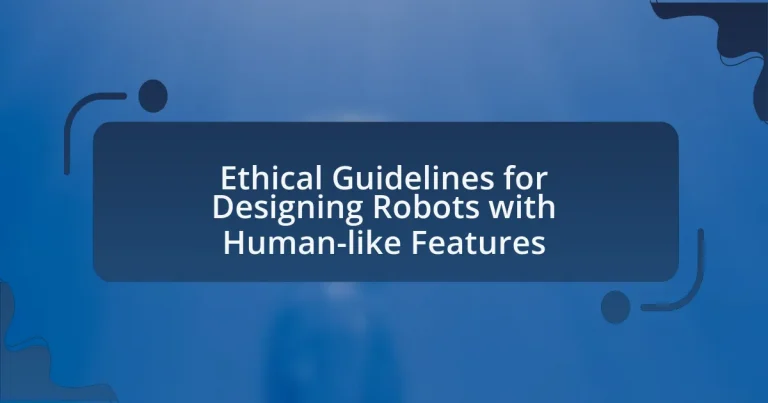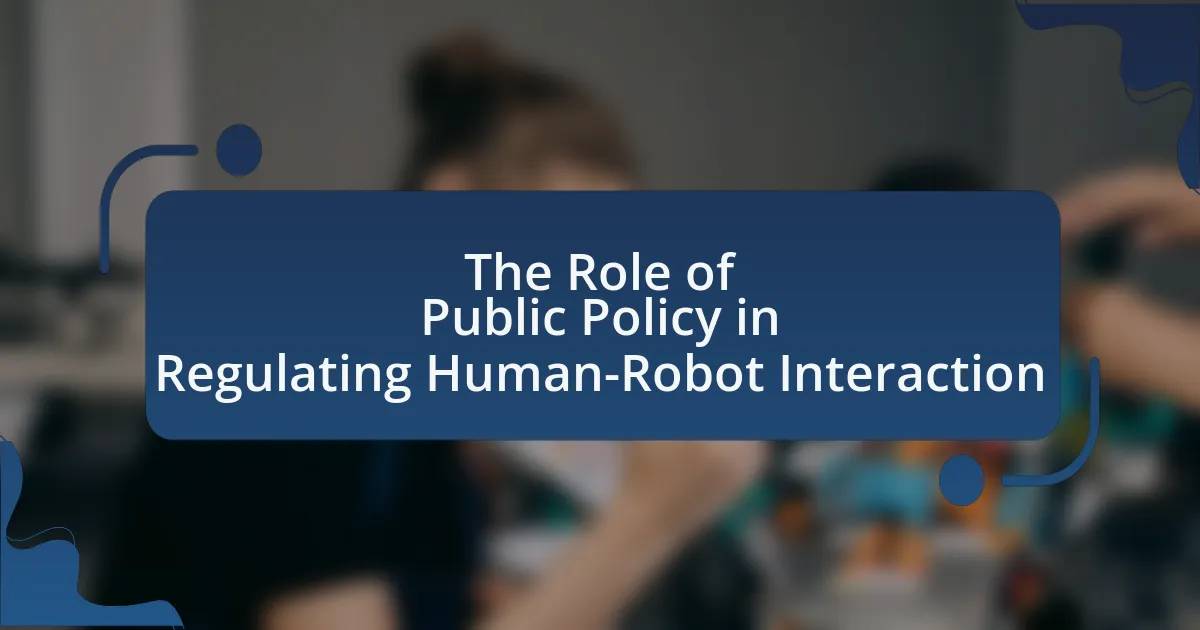The article focuses on ethical guidelines for designing robots with human-like features, emphasizing the importance of transparency, user safety, and privacy. It outlines the ethical concerns associated with human-like robots, such as autonomy and manipulation, and discusses how these guidelines influence robot design by prioritizing human dignity and rights. Additionally, the article examines the impact of cultural differences on ethical standards, the psychological effects of human-like features on users, and best practices for ensuring ethical compliance in robot development. It highlights the necessity of continuous feedback and education to address challenges in adhering to ethical guidelines in robotics.

What are Ethical Guidelines for Designing Robots with Human-like Features?
Ethical guidelines for designing robots with human-like features include ensuring transparency, promoting user safety, and respecting user privacy. Transparency involves clearly communicating the robot’s capabilities and limitations to users, which helps manage expectations and fosters trust. Promoting user safety requires implementing fail-safes and ensuring that robots do not cause physical or psychological harm. Respecting user privacy entails safeguarding personal data collected by robots and ensuring that users are informed about data usage. These guidelines are supported by frameworks such as the IEEE Global Initiative on Ethics of Autonomous and Intelligent Systems, which emphasizes the importance of ethical considerations in technology design.
Why are ethical guidelines important in robotics?
Ethical guidelines are important in robotics to ensure the safe and responsible development and deployment of robotic systems. These guidelines help prevent harm to humans and society by establishing standards for behavior, accountability, and transparency in robotic design and operation. For instance, the IEEE Global Initiative on Ethics of Autonomous and Intelligent Systems emphasizes the need for ethical considerations to address issues like privacy, security, and bias in AI systems. By adhering to ethical guidelines, developers can mitigate risks associated with human-robot interactions and promote trust in robotic technologies.
What ethical concerns arise from human-like robots?
Ethical concerns arising from human-like robots include issues of autonomy, privacy, and the potential for manipulation. Human-like robots may blur the lines between human and machine, leading to questions about the rights and responsibilities of these entities. For instance, the use of robots in caregiving roles raises concerns about emotional attachment and dependency, which can affect human relationships. Additionally, the data collection capabilities of these robots pose significant privacy risks, as they may gather sensitive information without consent. Research by the European Commission’s High-Level Expert Group on Artificial Intelligence highlights the importance of ensuring that AI systems respect fundamental rights and ethical principles, emphasizing the need for transparency and accountability in their design and deployment.
How do ethical guidelines influence robot design?
Ethical guidelines significantly influence robot design by establishing standards that prioritize human safety, dignity, and rights. These guidelines shape the development process by ensuring that robots are designed to avoid causing harm, respect user privacy, and promote fairness. For instance, the Asilomar AI Principles emphasize the importance of aligning AI systems, including robots, with human values and ethical considerations, which directly impacts design choices such as transparency and accountability. Furthermore, adherence to ethical frameworks can lead to the incorporation of features that enhance user trust and acceptance, ultimately guiding the creation of robots that are not only functional but also socially responsible.
What principles underpin ethical guidelines for robot design?
The principles that underpin ethical guidelines for robot design include safety, transparency, accountability, and respect for human rights. Safety ensures that robots do not harm humans or the environment, as highlighted by the IEEE’s Ethically Aligned Design framework, which emphasizes the importance of minimizing risks associated with robotic systems. Transparency involves clear communication about a robot’s capabilities and limitations, fostering trust between users and technology. Accountability mandates that designers and manufacturers are responsible for the actions of their robots, ensuring that ethical standards are upheld. Lastly, respect for human rights ensures that robots enhance human dignity and do not infringe upon personal freedoms, aligning with the UN’s Universal Declaration of Human Rights. These principles collectively guide the ethical development of robots, particularly those with human-like features, to promote beneficial interactions with society.
How do respect and dignity factor into robot design ethics?
Respect and dignity are fundamental principles in robot design ethics, as they guide the creation of robots that interact with humans in a socially acceptable manner. Designers must ensure that robots are programmed to recognize and uphold human dignity, avoiding actions that could be perceived as disrespectful or dehumanizing. For instance, the IEEE Global Initiative on Ethics of Autonomous and Intelligent Systems emphasizes the importance of human-centered design, which includes respecting individual autonomy and promoting human welfare. This ethical framework supports the idea that robots should enhance human experiences rather than undermine them, thereby reinforcing the necessity of integrating respect and dignity into their design.
What role does transparency play in ethical robot design?
Transparency is crucial in ethical robot design as it fosters trust between users and robots. When robots operate transparently, users can understand their decision-making processes, which mitigates fears of unpredictability and misuse. For instance, a study by the IEEE Global Initiative on Ethics of Autonomous and Intelligent Systems emphasizes that transparency in algorithms allows users to comprehend how robots arrive at specific actions, thereby enhancing accountability. This understanding is essential for ethical considerations, as it ensures that robots align with societal values and norms, ultimately promoting responsible integration into daily life.
How do cultural differences impact ethical guidelines for robots?
Cultural differences significantly impact ethical guidelines for robots by shaping societal values, norms, and expectations regarding technology. For instance, in collectivist cultures, such as Japan, robots are often viewed as companions and integral members of society, leading to ethical guidelines that emphasize harmony and social cohesion. Conversely, in individualistic cultures like the United States, ethical considerations may focus more on personal autonomy and privacy, resulting in guidelines that prioritize user consent and data protection. Research by the IEEE Global Initiative on Ethics of Autonomous and Intelligent Systems highlights that these cultural perspectives influence how robots are designed, deployed, and regulated, underscoring the necessity for culturally sensitive ethical frameworks in robotics.
What are the varying ethical standards across different cultures?
Varying ethical standards across different cultures reflect diverse beliefs, values, and social norms that influence moral judgments. For instance, collectivist cultures, such as those in East Asia, prioritize community and familial obligations, often valuing harmony and group welfare over individual rights. In contrast, individualistic cultures, like those in Western Europe and North America, emphasize personal autonomy and individual rights, leading to different ethical considerations in areas such as privacy and consent. Research by Hofstede (1980) highlights these cultural dimensions, showing how power distance, uncertainty avoidance, and individualism versus collectivism shape ethical perspectives. This cultural variability necessitates careful consideration in the design of robots with human-like features to ensure they align with the ethical expectations of different societies.
How can designers accommodate cultural diversity in robot features?
Designers can accommodate cultural diversity in robot features by integrating culturally relevant aesthetics, behaviors, and communication styles into their designs. This approach ensures that robots resonate with users from various cultural backgrounds, enhancing user acceptance and interaction. For instance, incorporating culturally specific gestures, language options, and visual designs can make robots more relatable. Research indicates that culturally tailored robots improve user satisfaction and engagement, as seen in studies like “Cultural Adaptation in Human-Robot Interaction” by K. Dautenhahn, which highlights the importance of cultural context in technology acceptance.

What are the implications of human-like features in robots?
Human-like features in robots can significantly impact social interactions, ethical considerations, and user acceptance. These features can enhance empathy and trust, as studies show that people are more likely to engage positively with robots that exhibit human-like characteristics, such as facial expressions and gestures. For instance, research published in the journal “Robotics and Autonomous Systems” indicates that robots with human-like appearances can improve user satisfaction and emotional connection, leading to more effective collaboration in various settings, including healthcare and education. However, the introduction of human-like features also raises ethical concerns, such as the potential for manipulation or deception, as users may attribute human-like qualities to robots that do not possess genuine emotions or intentions. This duality necessitates careful consideration in the design and deployment of such robots to ensure they are used responsibly and ethically.
How do human-like features affect user interaction?
Human-like features significantly enhance user interaction by fostering a sense of familiarity and trust. When robots or digital interfaces exhibit human-like characteristics, such as facial expressions, voice modulation, or body language, users are more likely to engage positively. Research indicates that users respond more favorably to robots that display empathy and social cues, leading to improved communication and collaboration. For instance, a study published in the journal “Human-Computer Interaction” found that users rated interactions with humanoid robots as more satisfying and effective compared to non-human-like interfaces. This suggests that the incorporation of human-like features can lead to more meaningful and productive user experiences.
What psychological effects do human-like robots have on users?
Human-like robots can evoke a range of psychological effects on users, including increased empathy, attachment, and social interaction. Research indicates that users often project human emotions and social cues onto these robots, leading to feelings of companionship and emotional bonding. For instance, a study by Breazeal et al. (2004) demonstrated that users interacted more positively with robots that exhibited human-like features, resulting in enhanced emotional engagement. Additionally, the Uncanny Valley theory suggests that as robots become more human-like, they can elicit discomfort or eeriness when they appear almost, but not quite, human, which can affect user comfort levels and willingness to engage. This duality highlights the importance of carefully designing human-like features to maximize positive psychological effects while minimizing negative responses.
How can designers ensure positive user experiences with human-like robots?
Designers can ensure positive user experiences with human-like robots by prioritizing user-centered design principles, which focus on understanding user needs and preferences. This approach involves conducting thorough user research, including surveys and usability testing, to gather insights on how users interact with robots. For instance, studies have shown that robots designed with empathetic features, such as facial expressions and responsive behaviors, significantly enhance user satisfaction and trust. Additionally, incorporating clear communication protocols and ensuring intuitive interfaces can further improve user engagement and comfort. Research indicates that when users feel understood and valued by robots, their overall experience is markedly more positive.
What are the potential risks associated with human-like robots?
The potential risks associated with human-like robots include ethical concerns, safety issues, and psychological impacts. Ethical concerns arise from the potential for misuse, such as robots being programmed to deceive or manipulate humans. Safety issues can manifest if robots malfunction or are hacked, leading to physical harm. Psychological impacts may occur as humans develop emotional attachments to robots, which can affect social interactions and mental health. Research indicates that these risks necessitate careful consideration in the design and deployment of human-like robots to ensure they align with societal values and safety standards.
How can ethical guidelines mitigate risks in robot design?
Ethical guidelines can mitigate risks in robot design by establishing standards that prioritize safety, accountability, and user well-being. These guidelines help designers identify potential hazards, such as unintended harm to users or ethical dilemmas in decision-making processes. For instance, the IEEE Global Initiative on Ethics of Autonomous and Intelligent Systems provides a framework that emphasizes transparency and fairness, which can reduce biases in algorithmic decision-making. By adhering to such ethical standards, designers can create robots that not only comply with legal requirements but also align with societal values, thereby minimizing risks associated with misuse or malfunction.
What are the consequences of neglecting ethical considerations?
Neglecting ethical considerations in the design of robots with human-like features can lead to significant negative consequences, including harm to individuals and society. For instance, without ethical guidelines, robots may be programmed to prioritize efficiency over human safety, resulting in accidents or injuries. Additionally, the absence of ethical frameworks can foster mistrust among users, as seen in studies indicating that people are less likely to accept technology perceived as unethical, which can hinder technological adoption and innovation. Furthermore, neglecting ethics can lead to legal repercussions, as companies may face lawsuits or regulatory penalties for failing to adhere to ethical standards, impacting their reputation and financial stability.

What best practices should be followed in designing ethically responsible robots?
Designing ethically responsible robots requires adherence to several best practices, including transparency, accountability, and user-centered design. Transparency ensures that users understand how robots operate and make decisions, which builds trust and facilitates informed consent. Accountability mandates that designers and manufacturers are responsible for the actions and impacts of their robots, ensuring mechanisms are in place for addressing any harm caused. User-centered design focuses on the needs and values of users, promoting inclusivity and accessibility. These practices are supported by frameworks such as the IEEE Global Initiative on Ethics of Autonomous and Intelligent Systems, which emphasizes the importance of ethical considerations in technology development.
How can designers implement ethical guidelines effectively?
Designers can implement ethical guidelines effectively by integrating ethical considerations into the design process from the outset. This involves conducting thorough research on ethical implications, engaging stakeholders in discussions about potential impacts, and adhering to established ethical frameworks such as the IEEE Global Initiative on Ethics of Autonomous and Intelligent Systems. For instance, the IEEE guidelines emphasize transparency, accountability, and fairness, which can be operationalized through design choices that prioritize user safety and privacy. By systematically applying these principles, designers can ensure that their creations align with societal values and ethical standards.
What tools and frameworks assist in ethical robot design?
Tools and frameworks that assist in ethical robot design include the IEEE Global Initiative on Ethics of Autonomous and Intelligent Systems, which provides guidelines for ethical considerations in AI and robotics. Additionally, the Asilomar AI Principles outline key ethical principles for AI development, emphasizing safety and transparency. The RoboEthics framework focuses on the ethical implications of robotics in society, promoting responsible design and deployment. These frameworks are supported by research, such as the work by Lin, Abney, and Bekey in “Robot Ethics: The Ethical and Social Implications of Robotics,” which highlights the importance of ethical considerations in robotic design and deployment.
How can continuous feedback improve ethical compliance in robot design?
Continuous feedback can enhance ethical compliance in robot design by enabling iterative improvements based on real-time assessments of ethical implications. This process allows designers to identify and address ethical concerns as they arise, ensuring that robots align with societal values and ethical standards. For instance, incorporating user feedback during the design phase can reveal potential biases or unintended consequences, leading to modifications that promote fairness and accountability. Research indicates that organizations employing continuous feedback mechanisms in technology development report higher adherence to ethical guidelines, as they can adapt quickly to emerging ethical dilemmas.
What are common challenges in adhering to ethical guidelines?
Common challenges in adhering to ethical guidelines include ambiguity in ethical standards, conflicting stakeholder interests, and rapid technological advancements. Ambiguity arises when ethical guidelines are not clearly defined, leading to varied interpretations among designers and developers. Conflicting interests occur when stakeholders, such as manufacturers, consumers, and regulatory bodies, prioritize different outcomes, complicating consensus on ethical practices. Rapid technological advancements can outpace existing ethical frameworks, making it difficult to apply established guidelines to new scenarios, as seen in the development of AI and robotics. These challenges highlight the need for ongoing dialogue and adaptation of ethical standards in the context of evolving technologies.
How can designers overcome resistance to ethical practices?
Designers can overcome resistance to ethical practices by actively engaging stakeholders in discussions about the importance of ethics in design. This engagement fosters a shared understanding of ethical implications and encourages collaboration. For instance, research by the Design Council indicates that involving diverse perspectives in the design process leads to more ethically sound outcomes, as it highlights potential ethical dilemmas early on. By prioritizing transparency and education about ethical standards, designers can build a culture that values ethical considerations, ultimately reducing resistance.
What strategies can be employed to educate stakeholders about ethics in robotics?
To educate stakeholders about ethics in robotics, organizations can implement comprehensive training programs that focus on ethical principles, case studies, and real-world applications. These programs should include interactive workshops, seminars, and online courses that engage participants in discussions about ethical dilemmas and decision-making processes in robotics. Research indicates that experiential learning, such as simulations and role-playing scenarios, enhances understanding and retention of ethical concepts (Borenstein et al., 2017, “The Ethics of Autonomous Cars,” Science and Engineering Ethics). Additionally, creating collaborative platforms for stakeholders to share insights and experiences can foster a culture of ethical awareness and responsibility in robotics development.
What practical tips can enhance ethical robot design?
To enhance ethical robot design, developers should prioritize transparency in the robot’s decision-making processes. Transparency allows users to understand how robots make choices, fostering trust and accountability. For instance, implementing clear algorithms and providing explanations for actions taken by robots can help users grasp the underlying logic, which is essential for ethical interactions. Additionally, incorporating user feedback mechanisms ensures that robots can adapt to societal norms and values, aligning their functions with ethical standards. Research indicates that user involvement in design leads to more socially acceptable robots, as seen in studies conducted by the IEEE Global Initiative on Ethics of Autonomous and Intelligent Systems.





